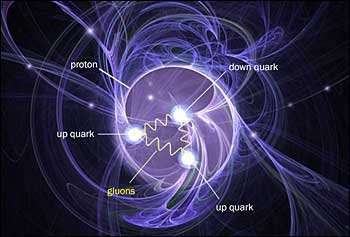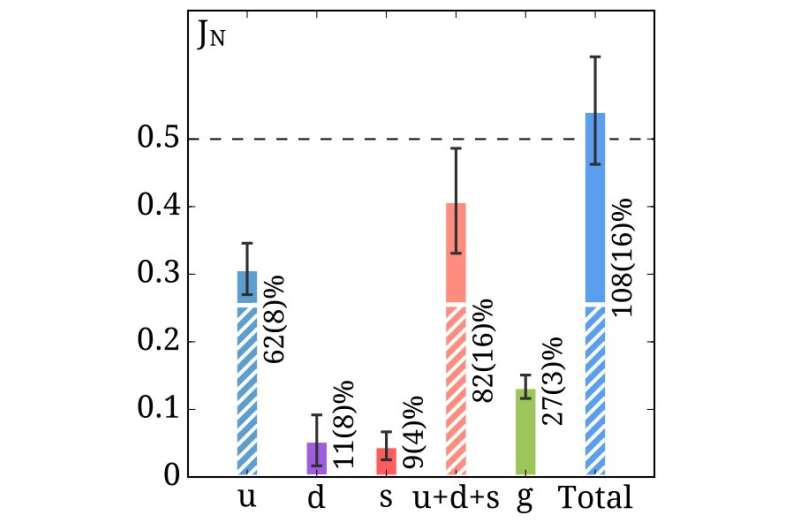Researchers make progress toward solving the proton spin puzzle

Scientists in a research group led by Constantia Alexandrou, professor of physics at the University of Cyprus and the Cyprus Institute, made a crucial step towards solving a three-decades-old puzzle: They have successfully deciphered the total angular momentum (spin) of the nucleon, determining how it's shared among its constituents. CSCS supercomputer Piz Daint provided the necessary computational resources.
Nucleons—protons and neutrons—are the principal constituents of atomic nuclei. Those particles in turn are made up of yet smaller elementary particles called quarks and gluons. Each nucleon has its own intrinsic angular momentum, or spin. Knowing the spin of elementary particles is important for understanding physical and chemical processes. Spin is responsible for a material's fundamental properties, for example, phase changes in non-conducting materials that suddenly turn them into superconductors at very low temperatures.
Theoretical models originally assumed that the spin of the nucleon came only from its constituent quarks. But in 1987, high-energy physics experiments conducted by the European Muon Collaboration precipitated what came to be known as the "proton spin crisis." Experiments performed at CERN, DESY and SLAC showed that quarks contribute only 30 percent of the proton spin. Since then, it has been unclear what other effects contribute to the spin, and to what extent. The high-energy physics studies suggested that quark-antiquark pairs with their short-lived intermediate states might be in play here—in other words, purely relativistic quantum effects.
Thirty years later, these mysterious effects have finally been accounted for in calculations performed on the CSCS supercomputer Piz Daint by a research group led by Constantia Alexandrou of the University of Cyprus in Nicosia; that group also included researchers from DESY-Zeuthen, Germany, and from Temple and Utah Universities, USA. For the first time, researchers were able to calculate the quantitative contributions from constituent quarks, gluons and sea quarks—sea quarks are a short-lived intermediate state of quark-antiquark pairs inside the nucleon—to nucleon spin. With their calculations, the group made a crucial step toward solving the puzzle that brought on the proton spin crisis.

To calculate the spin of the particles, the researchers have to account for the true physical mass of the quarks. "A numerically challenging task, but of essential importance for making sure that the values of the parameters in the simulations correspond to reality," says Karl Jansen, lead scientist at DESY-Zeuthen and project co-author. The strong force acting here, which is transmitted by the gluons, is one of the four fundamental forces of physics. The strong force is, indeed, strong enough to prevent the removal of a quark from a proton; this property, known as confinement, results in huge binding energy that ultimately holds together the nucleon constituents. The researchers used the mass of the pion, a so-called meson, consisting of one up and one down antiquark—the "light quarks"—to fix the mass of the up and down quarks to the physical quark mass entering in the simulations.
If the mass of the pion calculated from the simulation corresponds with the experimentally determined value, then the researchers consider that the simulation is done with the actual physical values for the quark mass. And that is exactly what Alexandrou and her researchers have achieved in their project, which was published today in the journal Physical Review Letters.
Their simulations also took into account the valence quarks (constituent quarks), sea quarks and gluons. The researchers used the lattice theory of quantum chromodynamics (lattice QCD) to calculate this "sea" of particles and their QCD interactions.
The biggest challenge with the simulations was to reduce statistical errors in calculating the "spin contributions" from sea quarks and gluons, says Alexandrou. "In addition, a significant part was to carry out the renormalisation of these quantities." In other words, they had to convert the dimensionless values determined by the simulations into a physical value that can be measured experimentally—such as the spin carried by the constituent and sea quarks and the gluons that the researchers were seeking. They are the first to include gluons in such computations, which required calculating millions of the "propagators" that describe how quarks move between two points in space-time.
"Making powerful supercomputers like Piz Daint open and available across Europe is extremely important for European science," notes Jansen. "Simulations as elaborate as this were possible only thanks to the power of Piz Daint, and because we pre-optimised our algorithms to make best use of the graphics processors of the machine," added Alexandrou.
More information: C. Alexandrou et al. Nucleon Spin and Momentum Decomposition Using Lattice QCD Simulations, Physical Review Letters (2017). DOI: 10.1103/PhysRevLett.119.142002
Journal information: Physical Review Letters
Provided by ETH Zurich



















